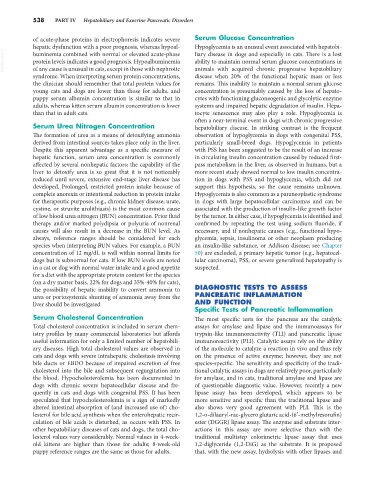Page 566 - Small Animal Internal Medicine, 6th Edition
P. 566
538 PART IV Hepatobiliary and Exocrine Pancreatic Disorders
of acute-phase proteins in electrophoresis indicates severe Serum Glucose Concentration
hepatic dysfunction with a poor prognosis, whereas hypoal- Hypoglycemia is an unusual event associated with hepatobi-
VetBooks.ir buminemia combined with normal or elevated acute-phase liary disease in dogs and especially in cats. There is a lost
ability to maintain normal serum glucose concentrations in
protein levels indicates a good prognosis. Hypoalbuminemia
of any cause is unusual in cats, except in those with nephrotic
disease when 20% of the functional hepatic mass or less
syndrome. When interpreting serum protein concentrations, animals with acquired chronic progressive hepatobiliary
the clinician should remember that total protein values for remains. This inability to maintain a normal serum glucose
young cats and dogs are lower than those for adults, and concentration is presumably caused by the loss of hepato-
puppy serum albumin concentration is similar to that in cytes with functioning gluconeogenic and glycolytic enzyme
adults, whereas kitten serum albumin concentration is lower systems and impaired hepatic degradation of insulin. Hepa-
than that in adult cats. tocyte senescence may also play a role. Hypoglycemia is
often a near-terminal event in dogs with chronic progressive
Serum Urea Nitrogen Concentration hepatobiliary disease. In striking contrast is the frequent
The formation of urea as a means of detoxifying ammonia observation of hypoglycemia in dogs with congenital PSS,
derived from intestinal sources takes place only in the liver. particularly small-breed dogs. Hypoglycemia in patients
Despite this apparent advantage as a specific measure of with PSS has been suggested to be the result of an increase
hepatic function, serum urea concentration is commonly in circulating insulin concentration caused by reduced first-
affected by several nonhepatic factors; the capability of the pass metabolism in the liver, as observed in humans, but a
liver to detoxify urea is so great that it is not noticeably more recent study showed normal to low insulin concentra-
reduced until severe, extensive end-stage liver disease has tion in dogs with PSS and hypoglycemia, which did not
developed. Prolonged, restricted protein intake because of support this hypothesis, so the cause remains unknown.
complete anorexia or intentional reduction in protein intake Hypoglycemia is also common as a paraneoplastic syndrome
for therapeutic purposes (e.g., chronic kidney disease; urate, in dogs with large hepatocellular carcinomas and can be
cystine, or struvite urolithiasis) is the most common cause associated with the production of insulin-like growth factor
of low blood urea nitrogen (BUN) concentration. Prior fluid by the tumor. In either case, if hypoglycemia is identified and
therapy and/or marked polydipsia or polyuria of nonrenal confirmed by repeating the test using sodium fluoride, if
causes will also result in a decrease in the BUN level. As necessary, and if nonhepatic causes (e.g., functional hypo-
always, reference ranges should be considered for each glycemia, sepsis, insulinoma or other neoplasm producing
species when interpreting BUN values. For example, a BUN an insulin-like substance, or Addison disease; see Chapter
concentration of 12 mg/dL is well within normal limits for 50) are excluded, a primary hepatic tumor (e.g., hepatocel-
dogs but is subnormal for cats. If low BUN levels are noted lular carcinoma), PSS, or severe generalized hepatopathy is
in a cat or dog with normal water intake and a good appetite suspected.
for a diet with the appropriate protein content for the species
(on a dry matter basis, 22% for dogs and 35%-40% for cats),
the possibility of hepatic inability to convert ammonia to DIAGNOSTIC TESTS TO ASSESS
urea or portosystemic shunting of ammonia away from the PANCREATIC INFLAMMATION
liver should be investigated. AND FUNCTION
Specific Tests of Pancreatic Inflammation
Serum Cholesterol Concentration The most specific tests for the pancreas are the catalytic
Total cholesterol concentration is included in serum chem- assays for amylase and lipase and the immunoassays for
istry profiles by many commercial laboratories but affords trypsin-like immunoreactivity (TLI) and pancreatic lipase
useful information for only a limited number of hepatobili- immunoreactivity (PLI). Catalytic assays rely on the ability
ary diseases. High total cholesterol values are observed in of the molecule to catalyze a reaction in vivo and thus rely
cats and dogs with severe intrahepatic cholestasis involving on the presence of active enzyme; however, they are not
bile ducts or EBDO because of impaired excretion of free species-specific. The sensitivity and specificity of the tradi-
cholesterol into the bile and subsequent regurgitation into tional catalytic assays in dogs are relatively poor, particularly
the blood. Hypocholesterolemia has been documented in for amylase, and in cats, traditional amylase and lipase are
dogs with chronic severe hepatocellular disease and fre- of questionable diagnostic value. However, recently a new
quently in cats and dogs with congenital PSS. It has been lipase assay has been developed, which appears to be
speculated that hypocholesterolemia is a sign of markedly more sensitive and specific than the traditional lipase and
altered intestinal absorption of (and increased use of) cho- also shows very good agreement with PLI. This is the
lesterol for bile acid synthesis when the enterohepatic recir- 1,2-o-dilauryl-rac-glycero glutaric acid-(6′-methylresorufin)
culation of bile acids is disturbed, as occurs with PSS. In ester (DGGR) lipase assay. The enzyme and substrate inter-
other hepatobiliary diseases of cats and dogs, the total cho- actions in this assay are more selective than with the
lesterol values vary considerably. Normal values in 4-week- traditional multistep colorimetric lipase assay that uses
old kittens are higher than those for adults; 8-week-old 1,2-diglyceride (1,2-DiG) as the substrate. It is proposed
puppy reference ranges are the same as those for adults. that, with the new assay, hydrolysis with other lipases and

